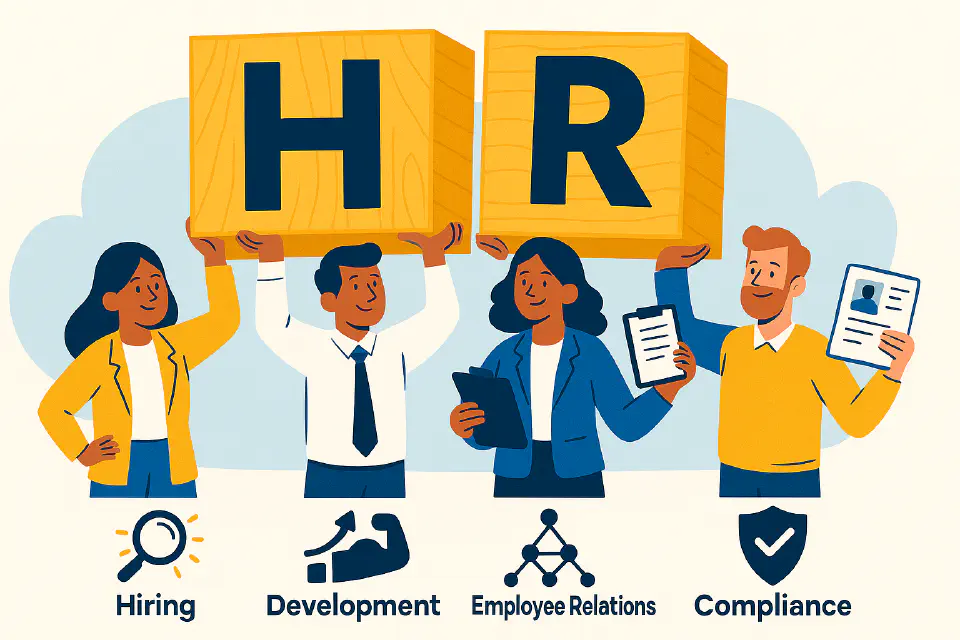
Responsibilities: What HR Actually Does (and Should Do)
HR isn’t just about hiring and firing. In practice, it’s a complex network of responsibilities — from legal compliance to engagement strategy — that shape how people work and thrive. This page outlines what HR actually does, and how each function contributes to organizational success.
The Scope of HR Responsibilities
The responsibilities of HR teams have grown significantly in recent years. What used to be focused on policies and payroll now spans talent strategy, data analytics, employee wellbeing, and digital experience.
HR today is expected to be both strategic and operational, balancing efficiency with empathy, and structure with agility.
Key HR Functions and Responsibilities
Below are the primary areas of responsibility in most modern HR teams. Depending on size and maturity, one person or several teams may cover each function.
1. Talent Acquisition
- Sourcing, attracting, and hiring the right people
- Building employer brand and candidate experience
- Using ATS tools and data to optimize recruitment
2. Onboarding & Offboarding
- Guiding new hires through their first 90 days
- Ensuring role clarity, connection, and compliance
- Managing exits with care, knowledge transfer, and feedback loops
3. Learning & Development (L&D)
- Designing training programs and growth paths
- Supporting manager capability and upskilling
- Integrating learning into daily workflows
4. Performance & Feedback
- Defining goals, feedback systems, and review cycles
- Supporting continuous feedback culture
- Linking individual performance to business outcomes
5. Compensation & Benefits
- Managing salary structures, equity, and benefits packages
- Ensuring pay equity and market alignment
- Communicating reward strategy clearly
6. Employee Relations & Compliance
- Handling workplace conflicts, investigations, and grievances
- Ensuring compliance with labor laws and policies
- Acting as an ethical sounding board and investigator
7. Engagement & Retention
- Running surveys, 1:1s, and listening strategies
- Acting on feedback to improve employee experience
- Creating programs that drive loyalty and motivation
8. Diversity, Equity & Inclusion (DEI)
- Embedding inclusive practices across the employee lifecycle
- Tracking metrics and building accountability
- Creating a sense of belonging and safety
9. HR Operations & Systems
- Managing HRIS, documents, and data integrity
- Owning process automation and policy governance
- Ensuring HR scalability as the company grows
10. Culture & Values
- Supporting rituals, behaviors, and symbolic leadership
- Operationalizing company values through policies and actions
- Acting as stewards of culture during change and growth
The Danger of Gaps or Overlaps
In many companies, HR responsibilities are:
- Vaguely defined
- Split across multiple people without coordination
- Missing entirely (e.g. no one owns onboarding or DEI)
This leads to inconsistent employee experience, operational inefficiencies, and dropped accountability.
Best Practice: Build a Clear Responsibility Map
Every HR team should have a clear map of what they own — and what they influence or support.
This includes:
- Primary ownership (e.g. TA owns hiring)
- Shared responsibility (e.g. L&D and Managers co-own development)
- Advisory/support roles (e.g. HRBP supports DEI initiatives)
Final Thought
HR responsibilities are often invisible until something breaks. But when done well, they provide the structure and support that allow teams — and the business — to thrive.
Investing in clearly defined responsibilities ensures HR isn’t just reacting, but actively shaping how work gets done.